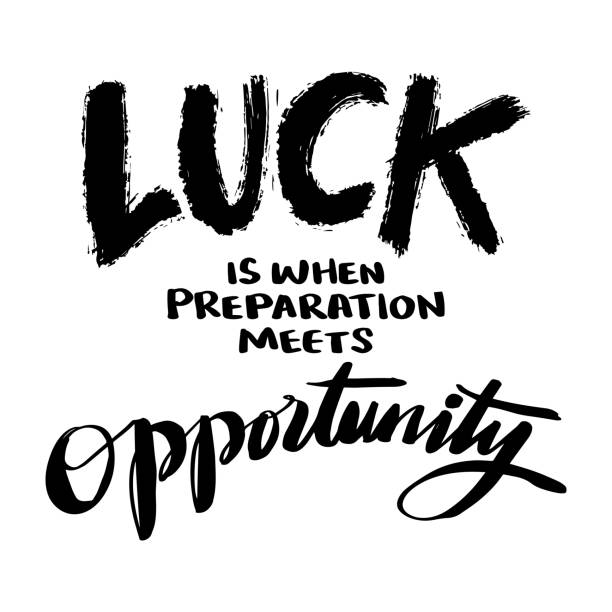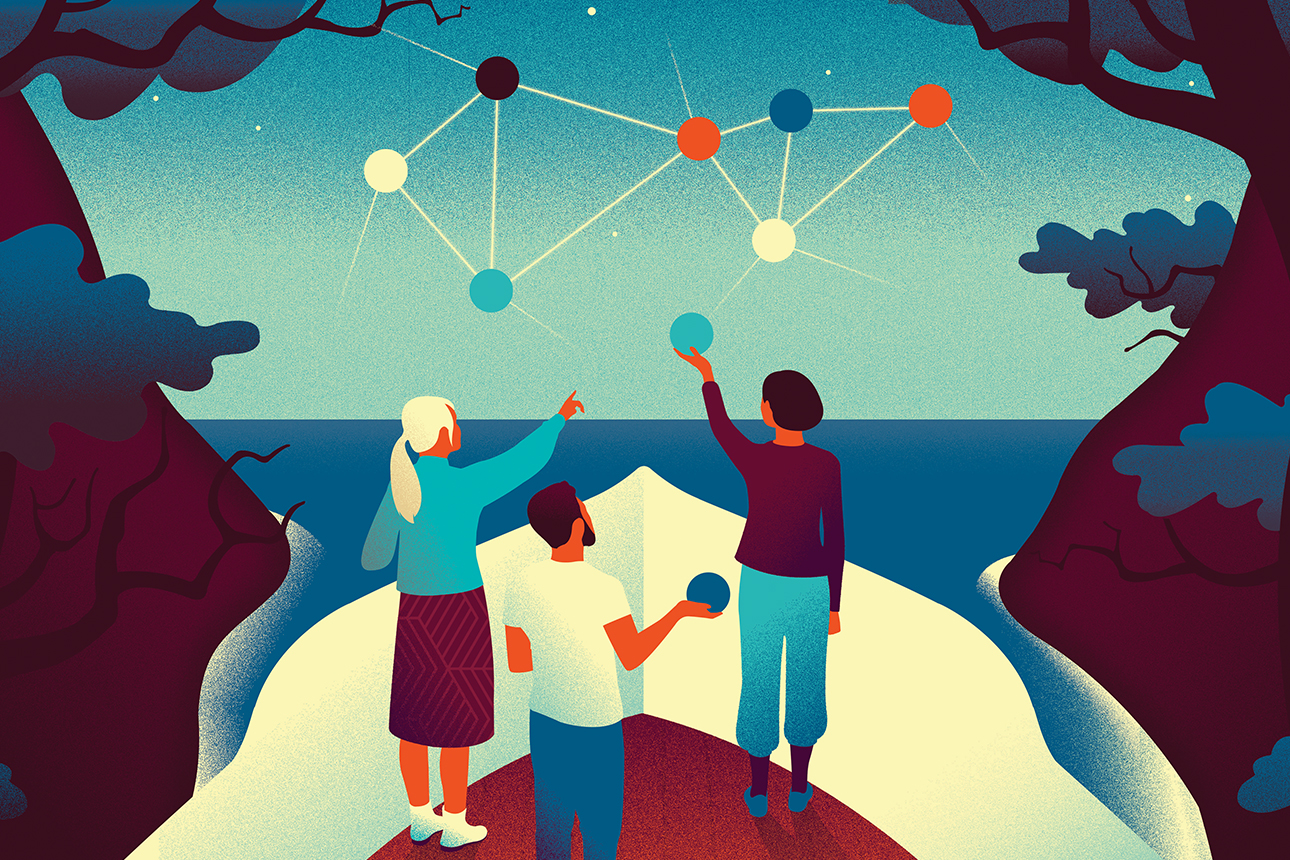
Luck Happens to People that are Ready
Introduction
Luck is often seen as a mysterious force, an unpredictable combination of circumstances that can alter the trajectory of life. However, what if luck isn’t just about chance? What if it can be cultivated, prepared for, and acted upon? This article explores how readiness can transform luck from a fleeting moment into a deliberate opportunity for success.
- Intended Audience and Purpose
This article is designed for individuals navigating moments of transition or seeking personal and professional growth. Whether you’re a student stepping into the workforce, an entrepreneur scaling a venture, a career changer exploring uncharted paths, or a retiree rediscovering purpose, the strategies here will inspire and empower you. The goal is to shift the perception of luck from an external occurrence to an internal readiness—equipping readers with actionable insights to align their preparation with life’s opportunities.
- Concept of Luck
Luck is more than random happenstance. It is the dynamic interplay of three key elements: preparation, opportunity, and timing.
- Preparation is about honing skills, cultivating a positive mindset, and building a foundation that can support success.
- Opportunity refers to recognizing and seizing favorable moments as they arise.
- Timing is about acting decisively and appropriately when those moments align.
While pure chance—like winning a lottery—relies on factors beyond control, actionable readiness ensures that when opportunities do arise, they can be recognized and utilized effectively. By viewing luck through this lens, we reclaim agency in our lives and make success less about circumstance and more about choice.
- Engaging Hook
Imagine this: tomorrow, you receive a call offering your dream job or a chance to pitch your groundbreaking idea. Are you ready to shine? Can you confidently seize the moment, or would doubt, lack of preparation, or hesitation hold you back?
Such scenarios are not fantasies; they occur regularly in our personal and professional lives. The difference between those who succeed and those who miss out often lies in their readiness to act when opportunity knocks.
- Thesis Statement
Luck is not an accidental windfall but a combination of preparation meeting opportunity. By fostering the right skills, mindset, and habits, you can transform luck from a passive hope into an active strategy. This article will guide you through the principles and practices that ensure you are always ready when luck happens.
This is the foundation for understanding how preparation, opportunity, and timing shape the perception and reality of luck. The subsequent sections will delve deeper into cultivating a readiness mindset, recognizing opportunities, and actionable strategies for aligning preparation with success.

The Power of Mindset
- The Foundation of Readiness
A strong mindset is the cornerstone of being ready for luck. The way you perceive challenges and opportunities directly influences your ability to act on them. Two critical elements underpin this foundation: optimism and growth-oriented thinking.
- Optimism as a Catalyst:
Optimism fosters a belief that good outcomes are possible, encouraging proactive behaviors. When you believe opportunities exist, you’re more likely to seek them out and take risks. Research shows that optimistic individuals are more resilient, which helps them recover quickly from setbacks and remain open to new possibilities
Growth-Oriented Thinking:
Adopting a growth mindset, as described by psychologist Carol Dweck, means viewing abilities and intelligence as developable through effort and learning. This perspective primes you to embrace challenges, learn from failure, and persist in the face of obstacles—all of which enhance readiness for luck【8†source
Psychological Benefits:
Resilience and confidence, by-products of optimism and growth thinking, amplify readiness. Resilient individuals adapt quickly to change and bounce back from adversity, ensuring they’re not sidelined by temporary setbacks. Confidence, meanwhile, inspires decisive action, allowing individuals to seize opportunities without hesitation.
- Fostering a Positive Outlook
A positive outlook doesn’t come naturally to everyone, but it can be cultivated through intentional practices. Here are some strategies to help attune your mindset to opportunity:
- Mindfulness Practices:
Mindfulness enhances focus and clarity, helping you identify opportunities as they arise. Regular meditation, breathing exercises, or even mindful journaling can improve awareness and reduce stress, enabling a calm and prepared state of mind source
Gratitude Exercises:
Practicing gratitude rewires the brain to notice positive aspects of life, fostering a sense of abundance. Start a daily gratitude journal, listing three things you’re thankful for. This simple habit shifts focus from scarcity to possibility, making you more receptive to opportunity
Visualization Techniques:
Imagining success or rehearsing positive outcomes mentally primes you for action when opportunities present themselves. Visualization increases confidence and reduces fear, making it easier to take bold steps.
- Reframing Challenges as Opportunities:
Shift the narrative around adversity. Instead of seeing challenges as threats, frame them as opportunities to learn and grow. This reframing fosters adaptability, a key trait for capitalizing on luck.
A strong mindset is not just an attitude but a strategic tool for readiness. By cultivating optimism, resilience, and adaptability, and adopting mindfulness and gratitude practices, you can train yourself to recognize and act on opportunities. When paired with preparation and effort, this mindset becomes a powerful force that transforms fleeting chances into deliberate success.

The Role of Preparation
Luck favors those who are ready to act when opportunity knocks. Preparation isn’t just about knowledge or skill—it’s about creating a comprehensive framework of readiness that spans personal growth, relationships, and routines. This section explores how building a toolkit, nurturing relationships, and establishing effective habits lay the groundwork for success.
- Building Your Toolkit
- The Importance of Diverse Skills:
In an ever-changing world, possessing a range of both technical and interpersonal skills is invaluable. Technical skills, such as proficiency in digital tools or industry-specific knowledge, provide tangible expertise. Interpersonal skills like communication, empathy, and collaboration enable you to navigate opportunities effectively. Together, they form a well-rounded arsenal for success.
For instance, a software developer with strong interpersonal skills can effectively pitch innovative ideas, while a teacher with digital literacy can explore e-learning platforms to expand their reach.
- Continuous Learning:
Lifelong learning is the cornerstone of preparation. Formal education provides foundational knowledge, but self-study and hands-on experience deepen expertise and adaptability.- Formal Learning: Enroll in courses or certifications to stay current in your field. Online platforms like Coursera, Udemy, or Khan Academy offer accessible resources.
- Self-Study: Read books, listen to podcasts, or explore open-access research to expand knowledge beyond formal structures.
- Hands-On Experience: Volunteer, freelance, or take up passion projects to gain practical skills and demonstrate initiative.
- Networking and Relationships
- Leveraging Networks:
Personal and professional networks act as catalysts for luck by opening doors to opportunities. Networking isn’t merely about meeting people; it’s about fostering meaningful connections.- Attend events, seminars, and workshops to expand your circle.
- Use platforms like LinkedIn to connect with peers and thought leaders in your industry.
- Stay active in communities, whether online forums or local groups, to remain visible and approachable.
- Reciprocity and Collaboration:
Relationships thrive on mutual benefit. Offering help, mentorship, or resources to others builds goodwill and fosters long-term collaboration. Reciprocity creates an ecosystem where opportunities flow naturally, benefiting both you and your network.
For example, sharing job leads with peers or volunteering time for a colleague’s project increases your chances of receiving support when you need it.
- Readiness and Routine
- Developing Daily Habits:
Consistency in preparation comes from well-defined routines. Incorporate habits that sharpen skills, enhance focus, and align with your goals.- Goal-Setting: Start each day with clear, actionable goals. Use frameworks like SMART (Specific, Measurable, Achievable, Relevant, Time-Bound) to structure objectives.
- Time Management: Prioritize tasks using tools like the Eisenhower Matrix, which categorizes activities based on urgency and importance.
- Reflective Journaling: Keep a journal to track progress, identify gaps, and maintain a proactive mindset.
- The Compounding Effect of Habits:
Small, consistent actions over time yield significant results. For example, dedicating 30 minutes daily to learning a new language or practicing a skill accumulates into expertise over months or years.
Preparation is not a one-time event but an ongoing process. By continuously building your skills, nurturing meaningful relationships, and embedding readiness into your daily routine, you set the stage for recognizing and capitalizing on opportunities. When luck arrives, you’ll be equipped not just to embrace it but to maximize its potential.

Recognizing and Seizing Opportunities
Opportunities often present themselves in subtle ways, and the ability to recognize and act on them can be the difference between missed potential and realized success. This section delves into the twin elements of awareness and decisiveness: how to spot opportunities as they arise and how to make informed decisions about pursuing them.
- Awareness and Timing
- Cultivate Situational Awareness:
Opportunities often come disguised as challenges, casual conversations, or unexpected situations. Being observant and open-minded helps in identifying these hidden prospects.- Practice Active Listening: Pay attention to what others are saying, as valuable insights and openings often emerge from dialogue.
- Stay Informed: Keeping abreast of industry trends, emerging technologies, and global events can alert you to shifts that create new opportunities.
- Use Reflective Observation: Regularly review your environment and assess how changes might align with your goals.
- Strategies for Evaluating Opportunities:
Once you identify a potential opportunity, the next step is a quick but effective evaluation.- Alignment with Goals: Does the opportunity align with your long-term aspirations and values?
- Feasibility Assessment: Consider whether you have the resources, time, and skills to pursue it.
- Potential Impact: Evaluate the potential return on investment, whether in terms of financial gain, skill development, or personal growth.
Tools like the SWOT analysis (Strengths, Weaknesses, Opportunities, Threats) can help clarify the merits and risks of a decision.
- Acting at the Right Time:
Timing is critical. Acting too quickly without adequate preparation may lead to mistakes, while waiting too long can result in missed chances. Cultivate a balance by setting deadlines for decisions and being prepared to pivot when necessary.
- The Art of Saying Yes
- When to Embrace New Challenges:
Saying “yes” to opportunities is often the first step toward growth. However, not all opportunities are created equal, and discerning which to pursue is key.- Stretch but Don’t Overreach: Choose opportunities that challenge your current capabilities but are within the realm of possibility. This balance fosters growth without creating burnout.
- Examples: A junior manager might accept a leadership role on a short-term project to develop managerial skills, or a student might take on an internship in a new industry to expand their experience.
- When to Hold Back:
Overcommitment can dilute focus and performance. It’s vital to recognize when an opportunity might not be the right fit.- Evaluate Opportunity Cost: Saying yes to one thing often means saying no to others. Weigh the cost of missed priorities before committing.
- Listen to Your Intuition: If something feels forced or misaligned with your values, it’s okay to decline.
- Real-Life Success Stories:
Examples of individuals who have turned unexpected opportunities into life-changing successes are both inspiring and instructive.- A professional who took a lateral job move to learn a new skill, leading to a promotion later.
- An entrepreneur who recognized a gap in the market during a casual conversation and built a thriving business around it.
Recognizing and seizing opportunities requires a blend of awareness, decisiveness, and strategic thinking. By staying observant, evaluating prospects thoughtfully, and balancing the willingness to take risks with a disciplined approach, you can ensure that no opportunity goes unnoticed or underutilized.

Embracing Change and Uncertainty
Luck often resides in the unknown, requiring individuals to navigate the unpredictable with resilience and openness. This section emphasizes adaptability as a critical strength and explores how to turn setbacks into stepping stones for future success.
- Adaptability as a Strength
- Flexibility in Changing Circumstances:
The ability to pivot and adjust quickly is crucial in a dynamic world. Adaptability ensures that when conditions shift—whether due to market changes, personal challenges, or global disruptions—you can still progress.- Example: Companies like Netflix pivoted from DVD rentals to streaming, thriving in a rapidly evolving industry. Similarly, individuals who embrace change can discover new paths to success.
- Strategies to Build Adaptability:
Being adaptable is a skill that can be nurtured through deliberate practice.- Scenario Planning: Regularly envision potential future scenarios and develop contingency plans. This proactive approach reduces fear of the unknown and provides clarity during uncertain times.
- Upskilling: Learning new skills ensures you remain relevant and prepared for unexpected opportunities. For example, digital literacy has become essential across industries, making it a valuable area for ongoing development.
- Mindset Shifts: Embrace curiosity and see change as an opportunity to explore new possibilities rather than a disruption.
- Learning from Setbacks
- Failures as Opportunities for Growth:
Failure is an inevitable part of progress. By reframing it as a learning experience, individuals can extract valuable lessons and recalibrate their approach.- Example: Thomas Edison famously viewed each failed attempt at inventing the light bulb as a step closer to success. His mindset exemplifies how setbacks can fuel innovation.
- Benefits: Failure builds resilience, encourages creative problem-solving, and highlights areas for improvement.
- Tools for Reframing Adversity:
- Reflection: Journaling or discussing setbacks helps identify what went wrong and why.
- Growth-Focused Questions: Ask, “What did I learn?” and “How can I improve?” to shift the focus from blame to solutions.
- Celebrate Effort: Recognize the courage it took to try, even if the outcome wasn’t ideal, and use it as motivation to persist.
- Maintaining Momentum After Setbacks:
- Revisit your goals and adjust timelines or approaches based on new insights.
- Seek support from mentors, peers, or networks to gain fresh perspectives and encouragement.
- Create short-term milestones to rebuild confidence and maintain forward motion.
Adaptability and resilience are critical in turning uncertainty into opportunity. By fostering a mindset of flexibility, preparing for change, and viewing setbacks as growth experiences, you can navigate life’s unpredictabilities with confidence. These qualities ensure that you are not only ready when luck happens but also able to create luck in the face of adversity.

Actionable Strategies to Be Ready
Preparation is not just a mindset or a collection of skills; it’s also a deliberate and structured approach to aligning your efforts with potential opportunities. This section provides specific, actionable strategies to ensure you’re consistently prepared for when luck intersects with effort.
- Create a Readiness Plan
A structured plan provides clarity and direction, helping you remain focused on your goals while staying adaptable.
- Template for a Readiness Plan:
Break down your readiness strategy into three actionable components:- Define Your Goals: Specify what you want to achieve in the short and long term. Use SMART criteria to make your goals clear and achievable. For example:
- Short-term: “Learn Python programming within six months.”
- Long-term: “Transition into a data analyst role within two years.”
- Identify Resources: List the tools, people, or experiences you need to achieve your goals.
- Resources could include mentors, educational courses, networking events, or financial savings.
- Track Progress: Use a system like a progress tracker, habit journal, or goal-setting app to measure milestones and refine your plan as needed. Tools like Trello or Notion can help organize and visualize your objectives.
- Define Your Goals: Specify what you want to achieve in the short and long term. Use SMART criteria to make your goals clear and achievable. For example:
- Reflection and Adjustment:
Regularly review your plan to ensure it remains aligned with evolving priorities and circumstances. Schedule periodic check-ins—monthly or quarterly—to assess what’s working and what needs adjustment.
- Expand Your Horizons
Exposure to new experiences broadens your perspective and enhances your readiness for unforeseen opportunities.
- Explore New Fields and Hobbies:
Stepping outside your comfort zone can reveal hidden talents and interests. For instance:- Experiment with creative hobbies like painting, writing, or photography to build problem-solving and lateral thinking skills.
- Explore industries unrelated to your current field to uncover emerging trends or potential career shifts.
- Connect with Diverse Groups:
Engaging with individuals from various cultural, professional, or socioeconomic backgrounds fosters fresh perspectives and ideas. This can be achieved through:- Volunteering for community projects.
- Joining interest-based groups, such as book clubs or tech meetups.
- Traveling to new places to experience different cultures and ideas firsthand.
- Examples of Horizon Expansion:
A marketing professional learning coding might unlock opportunities in tech-enabled advertising. Similarly, a lawyer exploring creative writing might discover a passion for legal storytelling or public speaking.
- Leverage Technology
Technology amplifies readiness by connecting you with resources, networks, and tools that streamline your efforts.
- Professional Platforms:
- Use LinkedIn to showcase your skills, connect with industry professionals, and stay updated on job opportunities.
- Participate in online forums like Reddit or Quora to engage in discussions and gain insights from diverse communities.
- Online Learning Resources:
- Enroll in courses on platforms like Coursera, Udemy, or Khan Academy to learn new skills. For instance:
- Take a data analytics course if transitioning into a data-driven role.
- Explore design thinking workshops for creative problem-solving.
- Enroll in courses on platforms like Coursera, Udemy, or Khan Academy to learn new skills. For instance:
- Productivity Tools:
- Use apps like Asana or Todoist for task management and goal tracking.
- Employ habit-tracking apps such as Habitica to build and maintain positive routines.
- Technological Alerts and Trends:
Set up Google Alerts or follow key influencers in your field to stay informed about industry developments and upcoming opportunities.
Actionable strategies form the bedrock of readiness. By creating a clear plan, seeking out new experiences, and leveraging the power of technology, you can position yourself as someone prepared to turn chance into opportunity. Readiness isn’t just about preparation; it’s about building a life that constantly aligns with growth and serendipity.

Case Studies and Real-World Applications
The theoretical concepts explored in the earlier sections come to life through real-world applications and success stories. In this section, we will examine how individuals and organizations have successfully prepared for and seized opportunities, transforming luck into concrete achievements.
- Relatable Success Stories
High-Profile Example: Oprah Winfrey
Oprah Winfrey’s journey from a tumultuous childhood to becoming a media mogul is a testament to the power of preparation meeting opportunity. Despite facing significant hardships, Oprah consistently demonstrated a readiness to learn, adapt, and seize opportunities.
- Preparation: Oprah worked relentlessly on improving her communication skills, both in terms of speaking and listening, long before her famous television appearances. She took every chance to educate herself on the evolving media landscape.
- Opportunity: The opportunity came when she was offered a role on a talk show in Chicago, which she initially viewed as just another job. However, she had the vision to see it as a stepping stone, and with time, transformed it into The Oprah Winfrey Show, creating a global platform.
- Outcome: Oprah’s success is not just about her breakthrough; it’s about how she remained ready for the right opportunity, making calculated decisions that aligned with her goals.
Everyday Success Story: Sarah, a Career Changer
Sarah, a mid-career professional in the retail industry, found herself feeling stagnant and unsure of her future. Over a period of several months, she began taking online courses in data analysis, seeking mentorship from industry leaders, and attending networking events.
- Preparation: Sarah wasn’t waiting for a perfect moment; she was actively preparing for a career change by learning new skills and expanding her professional network.
- Opportunity: Sarah’s luck came when a former colleague from the retail industry reached out, offering her a job in their data analytics division—an opportunity Sarah was ready for, thanks to her preparation.
- Outcome: Sarah not only landed the job but excelled in it, leveraging her newly acquired skills to propose data-driven strategies that led to improved business performance. Her story highlights how everyday individuals can turn preparation into success by simply being open to learning and growth.
Key Takeaway: Whether it’s high-profile individuals like Oprah Winfrey or everyday professionals like Sarah, the intersection of preparation and opportunity is universal. These stories illustrate that readiness is the true key to turning luck into success, regardless of background.
- Visual Aids
Visual tools help to underscore how preparedness creates patterns of success over time. These can serve as both motivational and practical guides for individuals looking to map their own paths to readiness.
Timeline: Oprah Winfrey’s Career Growth
A timeline can show Oprah’s gradual build-up of skills and opportunities, starting from her humble beginnings in media and culminating in her creation of OWN (Oprah Winfrey Network). This timeline can highlight key milestones like:
- Starting as a news anchor
- Transitioning to a talk-show host
- Expanding into other media ventures
- Leveraging personal experiences to create a global empire.
Graph: Success Rate of Career Changers vs. Non-Changers
This graph could illustrate the success rates of individuals who actively engage in upskilling (e.g., through courses or certifications) compared to those who rely solely on their current skill sets. It would show that those who prepare for change are significantly more likely to succeed in their transition.
Infographic: The Journey of Seizing Opportunities
An infographic could visually depict the steps individuals take to move from a passive state to an active state of readiness:
- Self-Assessment: Identify your current skill set and areas for improvement.
- Skill Development: Actively seek resources and learn new skills (online courses, workshops, etc.).
- Networking: Build relationships and stay informed about potential opportunities.
- Seizing Opportunities: Evaluate and act on opportunities quickly.
- Reflection and Adjustment: Continuously reflect on outcomes and adjust your strategy accordingly.
Case studies and visual tools provide valuable insights into the practical applications of being ready when luck happens. Success, whether on a global scale or in an individual’s career, is shaped by preparation and the ability to recognize and act on opportunities. These examples and tools not only inspire but also offer concrete steps to help you align your efforts with the next big opportunity that comes your way.

Conclusion
The journey of preparing for success, seizing opportunities, and embracing uncertainty is one that empowers individuals to turn “luck” into a deliberate outcome. Through understanding and applying key principles of readiness, mindset, and adaptability, you position yourself not only for success but for sustainable growth and fulfillment.
- Recap Key Insights
At the heart of readiness lies the dynamic interplay between preparation, mindset, and adaptability.
- Preparation is not just about accumulating knowledge or skills but also about aligning yourself with potential opportunities.
- Mindset is the foundation of this process. By cultivating optimism, resilience, and a growth-oriented perspective, you open yourself to new possibilities.
- Adaptability ensures that when opportunities arise, you are not just ready to seize them but can pivot effectively as circumstances change.
Being prepared is not about waiting for luck to strike—it’s about putting in the work, developing the right mindset, and positioning yourself to capitalize on moments when they arise.
- Call to Action
Ready to take the next step? Start small.
- Build one habit or skill today that prepares you for the next opportunity. Whether it’s reading a book on a subject you’re passionate about, joining a networking group, or simply setting a clear, actionable goal, every small action counts.
- Ask yourself, “What skill can I improve today to prepare for tomorrow’s opportunities?” This self-reflection is a powerful way to stay aligned with your growth journey and consistently move toward your goals.
Remember, your readiness is your responsibility. Every action you take now builds the foundation for future success.
- Participate and Donate to MEDA Foundation
As we focus on individual preparation, it’s essential to remember the power of collective readiness. Communities thrive when individuals are equipped with the tools, skills, and mindset needed to seize opportunities and overcome challenges.
- Join the MEDA Foundation’s mission in fostering self-sufficiency, empowerment, and opportunity for all. By supporting our work, you contribute to creating sustainable ecosystems where people—especially those with autism—can help themselves and others. Together, we can create a ripple effect of growth and empowerment across society.
- Donate to MEDA Foundation today and be a part of this meaningful change.
- Book Reading and Resources
For those seeking further insights into the topics of preparation, mindset, and personal growth, the following books and resources can be valuable:
- “Grit: The Power of Passion and Perseverance” by Angela Duckworth – This book delves into the importance of perseverance and passion in achieving long-term goals.
- “Atomic Habits” by James Clear – A practical guide on how small, incremental changes can lead to massive transformations in your life.
- “Mindset: The New Psychology of Success” by Carol Dweck – Explores how a growth mindset can open doors to endless possibilities.
- “The Power of Now” by Eckhart Tolle – A transformative read on the importance of living in the present moment and its power in shaping your future.
These books offer concrete strategies to align your efforts with your goals and build a life of readiness and success.
By embracing the principles shared in this article, you can position yourself not just for success, but for a life of continuous growth, learning, and fulfillment. The opportunity is always within your reach—be ready when it happens.









